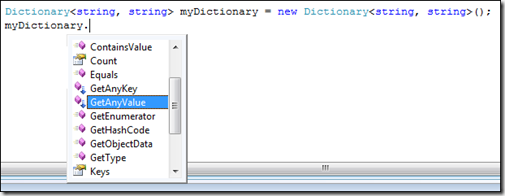“Method Extenders” is one of the most useful features introduced in the third version of .NET, which allows us to extend the features of a pre-built class. This small post will show you why you want them, how to use them, and the different versions of .NET you will need to deploy.
Why You Want Extension Methods? Just an Example
Imagine a collection of the type HashTable or Dictionary. It is sometimes convenient to retrieve ANY element of the collection. You don't want the first, you don't want the last (it would be non-sense talking about order in a hash table). You don't want any element in special, just one. The default HashTable or Dictionary collections don't have a GetAnyElement() method, so you would typically iterate through the collection getting the first element you find.
If this operation is done frequently over your code, and you are a clever developer, you won't be duplicating the same piece of code all around, and you will end up with some sort of static code like this:
public static string GetAnyValueOfDictionary(
Dictionary<string, string> pDictionary)
{
foreach (string value in pDictionary.Values)
return value;
return "";
}
This is nice, but… wouldn't it be MUCH nicer if that method was shown as an instance method (automatically recognized by the IntelliSense) instead of a static one inside a different class?
That is what extension methods give you. Pretty much like ExtenderProviders do at design time, adding properties to controls, ExtensionMethods tell the environment that the GetAnyValue() method is in fact a part of the specific Dictionary instance, so the invocation to the method is through each instance, not through an additional class.
The following is the old way of doing this stuff. Create a static class with some utility methods, and invoke them:
Dictionary<string, string> myDictionary = new Dictionary<string, string>();
string anyValue = DictionaryUtils.GetAnyValueOfDictionary(myDictionary);
This forces you to remember that there’s a DictionaryUtils class holding that code. Not anymore… This is the new way:
Dictionary<string, string> myDictionary = new Dictionary<string, string>();
string anyValue = myDictionary.GetAnyValue();
Fancy, uh?
What Do I Need to Use Them?
Theoretically, Extension Methods were introduced in .NET 3.0. However, if you try to use them directly, your compiler will say that needs a reference to System.Core.Dll. If you add that reference, you will realize that in fact is a .NET 3.5 DLL. So, here you can follow two different paths:
- Add a reference to System.Core.Dll, deploy your application as .NET 3.5, and jump to the next chapter
- If deploying your application as .NET 3.5 is not an option, you can always add the following code snippet:
namespace System.Runtime.CompilerServices
{
public class ExtensionAttribute : Attribute { }
}
This will allow the compiler to work with Extension Methods even in a .NET 2.0 application, as this blog post explains deeply.
How to Write Them?
Now you are ready to write your own extenders. Let’s see the example code for the GetAnyValue extension method:
public static string GetAnyValue(this Dictionary<string, string> source)
{
foreach (string key in source.Values)
return key;
return "";
}
As you can see, Method Extenders are written as static methods (inside a static class). Of course, you need a reference to the calling instance object, that’s why the infrequent word “this” appears in the parameters declaration.
The Type you specify on the right of the “this” keyword will state the kind of objects this method extends. Once you have the code, just add a “using” sentence (to the namespace you used for your “extenders” class) in every source file where you want to use them. Et voilá! Method extended… Easy as that:

Of course, you can combine this with Generics (using the <T> generic type), to make things even more functional.
Another Useful Example: A WordCount Method for the String Type
In this MSDN page, you can find another useful example: a WordCount method for the “string” type.
public static int WordCount(this string str)
{
return str.Split(new char[] { ' ', '.', '?' },
StringSplitOptions.RemoveEmptyEntries).Length;
}
Of course, you can put your own split char preferences there, but it’s indeed a handy method, isn't it?
Take care!
Inaki Ayucar is a Microsoft MVP in DirectX/XNA, and a software engineer involved in development since his first Spectrum 48k, in the year 1987. He is the founder and chief developer of The Simax Project (www.simaxvirt.com) and is very interested in DirectX/XNA, physics, game development, simulation, C++ and C#.
His blog is: http://graphicdna.blogspot.com
To contact Inaki: iayucar@simax.es
 General
General  News
News  Suggestion
Suggestion  Question
Question  Bug
Bug  Answer
Answer  Joke
Joke  Praise
Praise  Rant
Rant  Admin
Admin 






